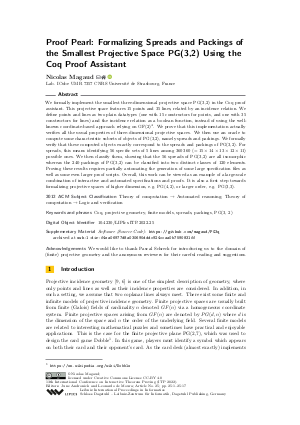@InProceedings{magaud:LIPIcs.ITP.2022.25,
author = {Magaud, Nicolas},
title = {{Proof Pearl: Formalizing Spreads and Packings of the Smallest Projective Space PG(3,2) Using the Coq Proof Assistant}},
booktitle = {13th International Conference on Interactive Theorem Proving (ITP 2022)},
pages = {25:1--25:17},
series = {Leibniz International Proceedings in Informatics (LIPIcs)},
ISBN = {978-3-95977-252-5},
ISSN = {1868-8969},
year = {2022},
volume = {237},
editor = {Andronick, June and de Moura, Leonardo},
publisher = {Schloss Dagstuhl -- Leibniz-Zentrum f{\"u}r Informatik},
address = {Dagstuhl, Germany},
URL = {https://drops.dagstuhl.de/entities/document/10.4230/LIPIcs.ITP.2022.25},
URN = {urn:nbn:de:0030-drops-167349},
doi = {10.4230/LIPIcs.ITP.2022.25},
annote = {Keywords: Coq, projective geometry, finite models, spreads, packings, PG(3, 2)}
}

 Creative Commons Attribution 4.0 International license
Creative Commons Attribution 4.0 International license





